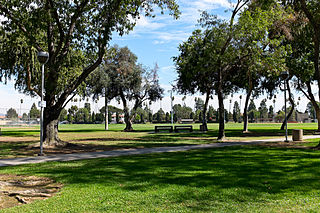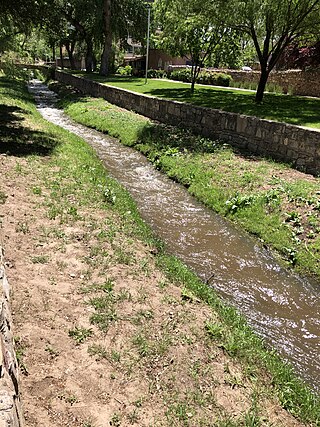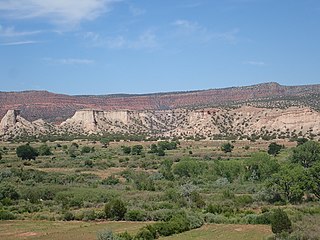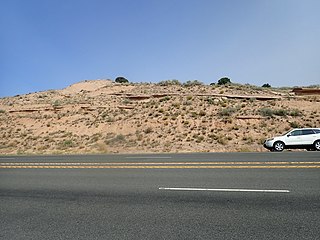Santa Fe or Santa Fé may refer to:

Santa Fe Springs is a city in Los Angeles County, California, United States. It is one of the Gateway Cities of southeast Los Angeles County. The population was 16,223 at the 2010 census, down from 17,438 in the 2000 census.

BNSF Railway is the largest freight railroad in the United States. One of six North American Class I railroads, BNSF has 36,000 employees, 33,400 miles (53,800 km) of track in 28 states, and over 8,000 locomotives. It has three transcontinental routes that provide rail connections between the western and eastern United States. BNSF trains traveled over 169 million miles in 2010, more than any other North American railroad.

The Atchison, Topeka and Santa Fe Railway, often referred to as the Santa Fe or AT&SF, was one of the largest Class 1 railroads in the United States.

The Hyundai Santa Fe is an automobile produced by the South Korean manufacturer Hyundai since 2000. It is a five-door crossover SUV that either has front-wheel drive or four-wheel drive. It is named after the city of Santa Fe, New Mexico, and was introduced for the 2001 model year as Hyundai's first SUV. The Santa Fe was a milestone in the company's restructuring program of the late 1990s because the SUV was a hit with American buyers. Between 2006 and 2012, the Santa Fe was positioned between the smaller Tucson compact crossover and the larger Veracruz. As of 2018, it is positioned between the Tucson and the larger Palisade.

Santa Fe Depot in San Diego, California, is a union station built by the Atchison, Topeka and Santa Fe Railway to replace the small Victorian-style structure erected in 1887 for the California Southern Railroad Company. The Spanish Colonial Revival style station is listed on the National Register of Historic Places and is a San Diego Historic Landmark. Its architecture, particularly the signature twin domes, is often echoed in the design of modern buildings in Downtown San Diego.

The Santa Fe River is a river in Santa Fe and Sandoval counties in New Mexico, United States, that is a tributary of the Rio Grande.

Santa Fe is the capital of the U.S. state of New Mexico. With a population of 87,505 at the 2020 census, it is the fourth-most populous city in the state. It is also the county seat of Santa Fe County. Its metropolitan area is part of the Albuquerque–Santa Fe–Los Alamos combined statistical area, which had a population of 1,162,523 in 2020. Human settlement dates back thousands of years in the region. The city was founded in 1610 as the capital of Nuevo México, replacing previous capitals at San Juan de los Caballeros and San Gabriel de Yunque; this makes it the oldest state capital in the United States.

The Santa Rosa Formation is a geologic formation exposed in New Mexico that was deposited in the Carnian Age of the late Triassic Period.

The Ortiz Mountains are a mountain range in northern New Mexico, United States, in Santa Fe County, northeast of the Sandia Mountains and due north of the San Pedro Mountains. The Ortiz include Placer Peak, the highest peak in the range at 8,858 feet, Lone Mountain at 7,310 feet, Cedar Mountain at 7,041 feet, Cerro Chato at 6,965 feet, and the foothills known as the Los Lomas de la Bolsa.

The Tesuque Formation is a geologic formation in north-central New Mexico, United States. The formation provides an unusually complete record of the evolution of mammals during the Miocene epoch.

The Zia Formation is a geologic formation in the southwestern Jemez Mountains and northwestern Santo Domingo basin. It contains vertebrate fossils that date it to early to middle Miocene in age.
Santa Rosa Formation may refer to:

The Santa Fe Group is a group of geologic formations in New Mexico and Colorado. It contains fossils characteristic of the Oligocene through Pleistocene epochs. The group consists of basin-filling sedimentary and volcanic rocks of the Rio Grande rift, and contains important regional aquifers.

The Ancha Formation is a geologic formation found near Santa Fe, New Mexico. It is estimated to be between 1 and 3 million years in age, corresponding to the late Pliocene and Pleistocene.

The Arroyo Ojito Formation is a late Miocene geologic formation exposed near Albuquerque, New Mexico. It records deposition of sediments in the Albuquerque Basin of the Rio Grande Rift after full integration of the Rio Grande through the basin.
The Blackshare Formation is a geologic formation exposed in the Hagan Basin west of the Ortiz Mountains of New Mexico. It is estimated be to of Miocene age.

The Servilleta Basalt or Servilleta Formation is a geologic formation that underlies most of the Taos Plateau of northern New Mexico. It has a radiometric age of 3.6 to 4.5 million years, corresponding to the Pliocene epoch.

The Cerro Conejo Formation is a middle to late Miocene geologic formation exposed near Albuquerque, New Mexico.

The Ceja Formation is a Pliocene to Pleistocene geologic formation exposed near Albuquerque, New Mexico, United States.
















